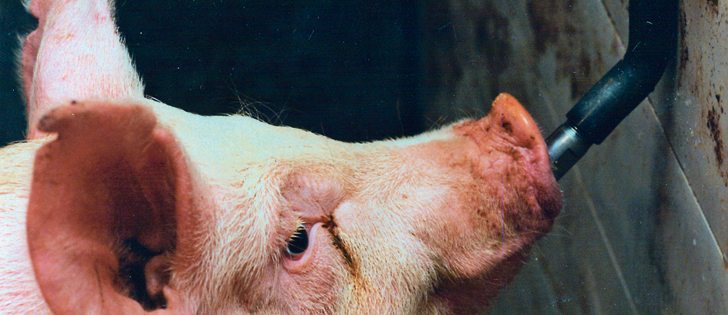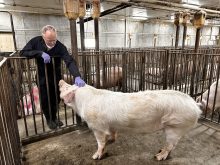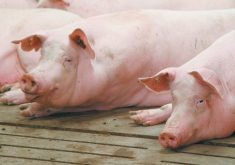Ontario hog farms that participated in a voluntary antimicrobial benchmarking project reduced their use of antimicrobials by 18 percent over two years.
The results of the Ontario Pork Industry Council study show what can be done when farmers actually know their antimicrobial use and the practices of their peers, says Dr. Greg Wideman, a veterinarian with South West Ontario Veterinary Services.
He presented the results of the 2016 study at the Ontario Swine Health Advisory Board’s annual Big Bug Day. A similar study was conducted in 2014.
Read Also

Farming Smarter receives financial boost from Alberta government for potato research
Farming Smarter near Lethbridge got a boost to its research equipment, thanks to the Alberta government’s increase in funding for research associations.
“We have demonstrated that a voluntary, antimicrobial use benchmarking project, based on producer interest, goodwill and engagement, is feasible, acceptable, it’s producing high quality results that we can take back to the farm and turn into action,” Wideman said.
The study involved 700,000 Ontario finisher pigs from more than 30 farms in each year.
It was started in 2014 to try to figure out how much antimicrobials were needed to raise a pig in Ontario.
The range of antimicrobial use was significant in the 2014 study, ranging from almost non-existent to extremely high in farms that happened to have had disease outbreaks that year, such as secondary infections after a porcine reproductive and respiratory syndrome (PRRS) outbreak.
There’s significant pressure for farmers to reduce or control the use of antimicrobials on farms to control bacteria, and the use of antimicrobials as growth enhancers is being reduced, Dr. Rob Bell, chief executive officer of Bio Agri Mix, told the same meeting, and such use will soon be off labels for antimicrobials.
Wideman said the decision was made to conduct a second study last year to have a comparison, especially with increasing interest in antimicrobial use on farms by consumers and regulators.
Three farms dropped out in 2016 because of various circumstances, but the number of sows increased as farms grew and one operation in particular added more of their sows to the study.
The study looked at the weight of antimicrobials used on the farms. In the 2016 study, the amount of pig live weight increased and the amount of antimicrobial use went down, which meant the milligrams of antimicrobial use per 100 kilograms of pig decreased by 18 percent.
After the 2014 study, a wrap-up meeting was held with producers and co-operators, which resulted in good conversations about antimicrobial management, said Wideman.
“I’m going to say because of active engagement in benchmarking and conversations that occurred during and after that process, there was a significant change in antimicrobials,” he said.
Seventy percent of the farms decreased their antibiotic use, “just from starting the conversation.” Some had disease challenges and did increase their use of antimicrobials.
When the working group looked at the farms where antimicrobial use increased, eight of 10 of them had a disease issue, including PRRS, mycoplasma and ileitis.
“The reality is that health status changes in Ontario, and when health status changes, one of the responses, sometimes the main response, is to use antibiotics to keep pigs alive,” Wideman said.
The study also looked at the types of antimicrobials that were used. Class I antimicrobials are those that are most important for human use. They are increasingly restricted for use in animals. The study showed that the total of Class I antibiotics used on the more than 30 farms was low.
“it’s not tens or hundreds of thousands of kilos of Class I antimicrobials, not by a long shot. It’s almost a rounding error away from zero, when we look at the whole antimicrobial use in this study,” he said.
““That’s a good news story.”
He said he also believes farmers understand the value of Class I antimicrobials and made decisions based on appropriate use.
The study was conducted using a confidential, web-based assessment tool developed by Boehringer Ingelheim. Wideman said the tool, call Compass, is scalable for many different uses in benchmarking antimicrobial use.


















